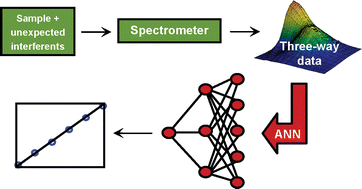Experimental study of non-linear second-order analytical data with focus on the second-order advantage
Abstract
Three different experimental systems have been studied regarding the determination of analytes in complex samples, using non-linear second-order instrumental data, which are intrinsically able to provide the second-order advantage. This permits the quantitation of calibrated analytes in the presence of unexpected sample components, although a suitable algorithm is required. The recently described combination of artificial neural networks with post-training residual bilinearization has been applied to the three data sets, with successful results concerning prediction accuracy and precision, as well as profile recovery for the potential interferents in test samples. The studies involve: (1) the determination of two pharmaceuticals in the presence of an unexpected excipient by absorbance–pH matrix measurements, (2) the quantitation of iron(II) by its catalytic effect on the kinetics of the bromate oxidation of a colorant in the presence of a second interfering organic dye, and (3) the analysis of the antibiotic amoxicillin by fluorescence excitation–emission matrices in the presence of a fluorescent anti-inflammatory. The prediction results were compared and shown to be significantly better than those yielded by the unfolded partial least-squares/residual bilinearization model, due to the non-linear nature of the studied data.


 Please wait while we load your content...
Please wait while we load your content...